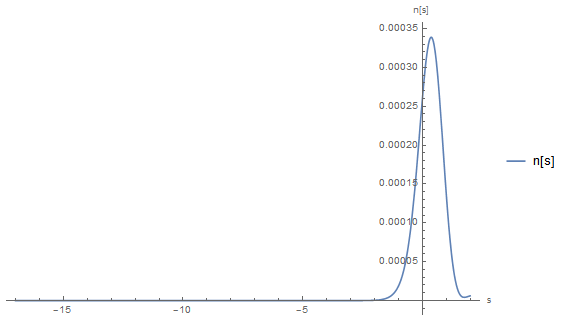I am trying to numerically solve the following integro-differential equation and get some plots for $n(s)$ vs $s$:
$$ \dot{n}(s)-\frac{\dot{w}(s)}{2w(s)}\int_{-\infty}^s ds'\frac{\dot{w}(s')}{w(s')}(1+2n(s'))\,\cos[2\int_{s'}^s ds'' w(s'')]=0 $$
with $\dot{w}(x)=\frac{dw(x)}{dx}$. The initial condition for $n(s=-\infty)=0$ can be considered and $w(s)$ is a general function of $s$ which one can consider as an example a function like $w(s)=a^2+\sqrt{c-d(1+Tanh[s])}$ with $a,c,d$ constants. I am new in Mathematica that is why I do not have a clear idea where to start. There are some different methods to solve these type of problems in the literature like Adomian, Galerkin methods, etc... but what I have here is a bit more involved than what people used to consider based on those methods...so I thought a numerical solution would be good idea to start with.
MMA code:
w[s_] := a^2 + Sqrt[c - d (1 + Tanh[s])]
Inactivate[n'[s] - w'[s]/(2 w[s])*Integrate[Cos[2 Integrate[w[x], {x, t, s}]]*(w'[t]/
w[t])*(1 + 2 n[t]), {t, -Infinity, s}] == 0, Integrate] // ExpandAll// TeXForm
$\frac{d \text{sech}^2(s) \int _{-\infty }^s\left(-\frac{d \cos \left(2 \int _t^s\left(a^2+\sqrt{c-d-d \tanh (x)}\right)dx\right) \text{sech}^2(t)}{2 \sqrt{c-d-d \tanh (t)} a^2+2 c-2 d-2 d \tanh (t)}-\frac{2 d \cos \left(2 \int _t^s\left(a^2+\sqrt{c-d-d \tanh (x)}\right)dx\right) n(t) \text{sech}^2(t)}{2 \sqrt{c-d-d \tanh (t)} a^2+2 c-2 d-2 d \tanh (t)}\right)dt}{4 a^2 \sqrt{c-d \tanh (s)-d}+4 c-4 d \tanh (s)-4 d}+n'(s)=0$




a,c,d? $\endgroup$